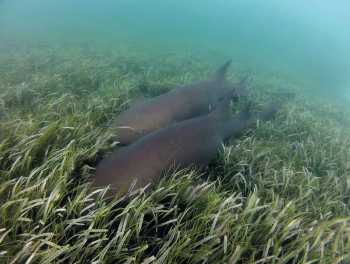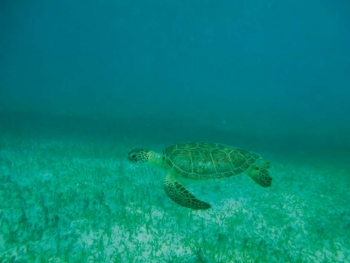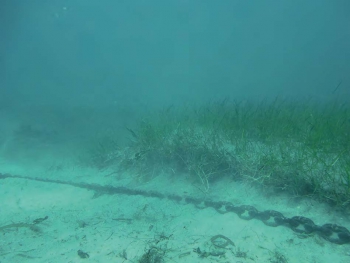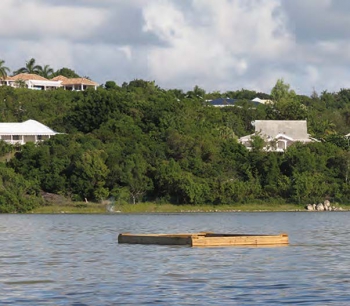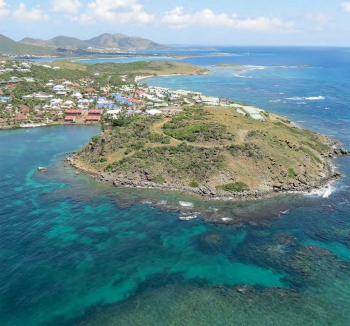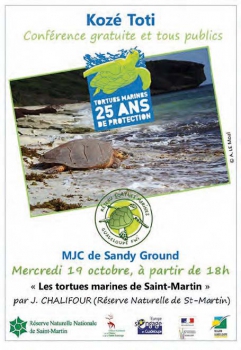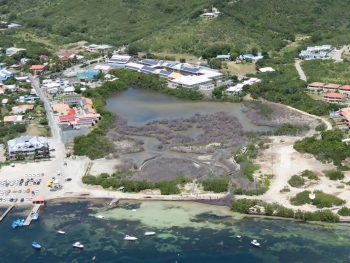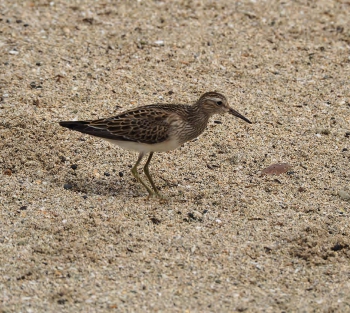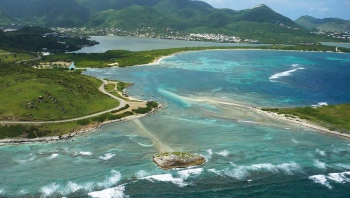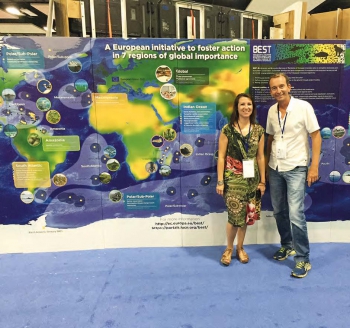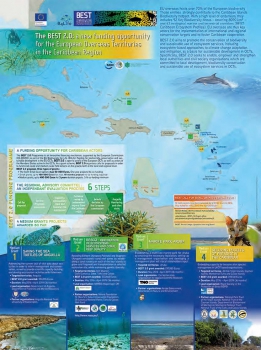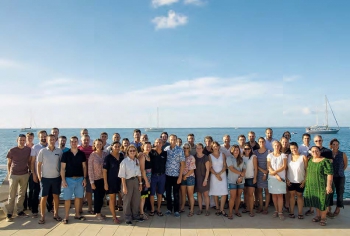- page 3 : L’amélioration des connaissances sur les espaces et les espèces protégées
- page 6 : La maîtrise des impacts anthropiques sur les espaces protégés
- page 8 : Actions de police
- page 9 : La restauration des milieux et des populations dégradés
- page 11 : La communication et l’éducation environnementale
- page 14 : Le renforcement de l’intégration régionale
Journal-27
Journal-27
Better Knowledge About Protected Areas And Protected Species
Why do female nurse sharks gather in large groups every summer, especially at Galion, but also at Caye Verte, or in Baie Blanche at Tintamare?
A university student in the Sea and Littoral Technician program at the Université du Littoral Côte d’Opale in Calais, and an intern for the French Antilles Shark Network, which is coordinated by the association Kap Natirel, Nicolas Boudin spent four months with the Réserve Naturelle studying this question. Thanks to placement of underwater cameras, he was able to determine that just the pregnant females were present at the sites that were selected to study. The fact that these sites all share the attribute of warm water, not too deep, might play a role in the progression of the shark’s gestation period. Why? The question remains to be answered. We simply know that the female nurse sharks, ovoviviparous, expulse their young and immediately move away from them, to avoid devouring them. The females generally adopt a protective behavior for their young by liberating them in zones not frequented by other adult sharks, and by ceasing their feeding for a short time.
Depuis 2007, la Réserve naturelle poursuit son suivi scientifique annuel des récifs et herbiers, qui s’est déroulé du 4 au 6 octobre 2016. Un garde de la réserve naturelle de Petite-Terre et un autre de la réserve marine de Saint-Barth étaient présents, afin d’aider l’équipe de Saint- Martin à collecter les données sous l’eau, sur les sites du Rocher Créole, de Pinel et de Tintamare et, hors de la Réserve, sur le site de Fish Pot, dans le canal d’Anguilla. Les données sont en cours de traitement. Dans le cadre de ce compagnonnage sous-marin entre réserves, Steeve Ruillet est allé prêté main-forte à Petite-Terre du 19 au 21 septembre et Julien Chalifour à Saint- Barth du 26 au 28 septembre. Le suivi scientifique des fonds marins de la Réserve naturelle a pour objectif de documenter l’évolution de leur état (communautés coralliennes et d’herbiers).
Already damaged by the use of anchors, the food pantry for our favorite green sea turtles has in the past few years also been invaded by a new species that is the object of tight surveillance.
Three American scientists, including Doctor Jeremy Kizska, were in Saint Martin on November 6-12 to observe the interaction between these turtles, which feed on the underwater plant beds, and Halophila stipulacea, a kind of sea grass. This invasive species was introduced via boat anchors and water from ballasts, and little-by-little takes up more-and-more space in the underwater herbier, where it is in competition with Syringodium and Thalassia, the two native species. From the International University of Florida, the scientists were hosted by the Réserve Naturelle, which had done a study on the same species in 2014. The three academics planned their project to span two years, and will soon return to our island. Their research is to estimate the density of the green sea turtle population, and study their feeding behavior in targeted zones. To be precise: comment do the turtles react when faced with this new species? The idea is to equip certain turtles with a GPS and use underwater cameras to see what they select as food, if they go for the new species or if they simply munch on what is easily within their reach. The scientists had to wait for authorization from the DEAL in order to take various samples from the turtles in order to better understand their nutritional habits thanks to isotopic analysis. At Tintamare, so far they have taken samples of the herbier in order to make a map, and they have counted the number of turtles present at various plant beds at different times of the day.
Managing The Impact Of Human Activities In Protected Areas
The management of the sea grass bed at Tintimare’s Baie Blanche, where green sea turtles feed, was the focus of a study done by Charlotte Bousquet, who was an intern at the Réserve Naturelle from February through June 2016.
A master’s student in environmental sciences and littoral ecology at the University of La Rochelle, she started by marking a map of the herbier and evaluating its overall health. Next, she did a study on the usage of the bay by various kinds of boats, noting their size, if they belonged to an private individual or a nautical professional, and if they opted to use anchors rather than mooring buoys placed there for their use by the Réserve Naturelle. Based on her early results, Bousquet researched the impact that anchors and their chains have on the herbier, as they can leave serious scars. To do so, she identified three sectors: the zone where the buoys are placed; the mooring zone behind the buoys where certain sailors prefer to anchor; and the zone located to the south of the bay, where boats very rarely anchor. Conclusion: the overall health of the plant bed is good, in spite of the presence of small areas where anchors have more impact than others. At the same time, the practice of mooring with an anchor is more often the choice of private individuals, rather than the professionals. As for the level of usage, generally not too high, there are peaks, at which time there can be as many as 15 motorboats at the same time, but for a limited amount of time, usually the days when several cruise ships are in the port of Philipsburg. This report puts an accent on the need to reinforce the awareness for individuals and get everyone thinking about refining the usage and moorings in the center of this zone.
In mid-October, the Réserve placed a raft in the water of the Grand Étang, in Terres Basses, in order to encourage resting and nesting for least terns, of which there are 75 on the site this year.
The idea is to protect this migratory bird, a species whose conservation status is «endangered» on a world level and «vulnerable» on the local level. Very sensitive to disturbances, the least tern makes its nest along the edge of the salt ponds, on the sand, and its eggs and not protects from a sudden rise in water levels or a hungry rat or dog. This would no longer be the case if the birds lay their eggs on the raft, out in the middle of the pond. This process exists elsewhere but this is a first for Saint Martin, and the Réserve is crossing its fingers that the birds will quickly adopt this new space. That could take more or less time, such as in the Camargue, where it took three years for the birds to finally nest on their raft. Six meters long and three meters wide, this floating structure is anchored in the pond and designed for the comfort of the birds: the bottom is covered with gravel and caches are available in the interior so that the baby birds can be protected from the elements. The Les residents of Terres Basses were receptive to this project once it was presented to them by the Réserve, and they are going to participate in its financing along with the Réserve and the Fondation du Patrimoine. The staff at the Réserve built the raft, as conceived and designed by Caroline Fleury, director of the land and lakes milieu study, supervised by Julien Chalifour and the scientific department of the Réserve.
Police Activity
Since January 1, 2016, the agents at the Réserve Naturelle have undertaken 130 controls at sea and 147 on land, which means the latter 147 were on land belonging to the Conservatoire du Littoral. These patrols resulted in 17 fines, including two for illegal fishing, five fiscal stamps, and five in which equipment was confiscated (harpoon gun, wooden gate, crab pots, fish traps, and a net). Two inter-service missions - with the ONCFS and the Gendarmerie - conducted two fishing controls for fishing in Saint Martin. Three notices were sent by certified mail and 23 verbal warnings were issued.
Bayside s’oppose à la réglementation
Après avoir dressé un premier procès-verbal en avril 2016 pour pratique d’une activité commerciale non autorisée sur un espace classé en réserve naturelle, les gardes ont dressé un second procès-verbal en septembre à l’encontre de l’un des deux exploitants de «Bayside riding club», pour avoir modifié l’état et l’aspect de la Réserve et effectué des travaux. L’un des associés s’était engagé en juin à respecter la réglementation et un procès-verbal de concertation avait été dressé après que le cadenas bloquant l’accès à la parcelle ait été sectionné. Pourtant, quelques jours plus tard, un portail était installé et équipé d’une chaîne et d’un cadenas. Le cadenas a été coupé et le portail saisi, par la Réserve naturelle. La Réserve et la gendarmerie suivent ce dossier
Restoration Of Degraded Areas And Populations
The ecological restoration of damaged areas, and the global replanting of Babit Point are on the to-do list for the Conservatoire du Littoral.
Phase one of the project is to create a botany trail open to the public, with lots of informational signage and an observation point. Enclosed regeneration areas will be built and their placement has already been determined.
Protected legally in Guadeloupe since November 1991 - when they still appeared on the menu in numerous restaurants - sea turtles were in the spotlight during the 25th anniversary celebration of this protective order, which is in effect in all the French Caribbean islands.
In Saint Martin, on October 19, at The Sandy Ground Cultural Centre, the Réserve Naturelle invited the population to «Kozé Toti,» a conference led by Julien Chalifour, head of the Réserve’s scientific department, and Sophie Bedel, from ONCFS Guadeloupe (National Office For Hunting and Wildlife). Students were not excluded from the events: on October 18-21, three representatives met with 6th and 7th grade students from the Mont des Accords middle school, first in their classrooms, then for two field trips on the beach in Galion. These youngsters learned all about the season in which different species of marine turtles lay their eggs and the importance of protecting their nests. The problems in protecting the sites where the eggs are laid were explained to the students: too much light, parking of vehicles, construction that can prevent the turtles from returning to lay their eggs. These field trips concluded with a beach cleaning exercise and collecting of mangrove seeds. These seeds, currently germinating at the Maison de la Réserve Naturelle, will be replanted along the salt ponds on the island, where certain mangroves have suffered from the consequences of El Nino in 2015.
Environmental Communication And Education
On September 6, 2016, the executive council of the Collectivité approved a land exchange with the Conservatoire du Littoral.
As owner of two pieces of land in the Quartier d’Orléans, the Conservatoire had suggested trading part of this land to the Collectivité in exchange for a natural site located along the edge of the Etang de la Barrière, in Cul-de-Sac. The land in the Quartier d’Orléans will be used in the construction of a new water treatment station (STEP). This trade is a win-win situation: The installation of the future STEP, designed to treat the wastewater of 18,000 residents, requires a large surface; and the Conservatoire, on the other hand, will have the possibility to manage the shores of the pond. This type of management, which is completely logical, is not possible on any of the salt ponds at the moment, as the property of the Conservatoire is limited to the water of the 14 ponds in question.
The Baie de l’Embouchure is one of eight pilot sites identified by the Conservatoire du Littoral as part of the Mang program, whose goal is to simplify the management of French overseas wetlands, in order to better preserve them.
The training of managers is planned, and in this light, the Réserve de Saint-Martin hosted ornithologist Anthony Levesque in order to strengthen the roles of Caroline Fleury and Ashley Daniel, in the field. To be able, for example, to differentiate the cry of a sandpiper from that of a chevalier, as both species were not visible at the moment they were counted during a scientific study. Run in conjunction with TeMeum and the Conservatoire du Llittoral, Mang is financed by the AFD and the European commission’s BEST program
To make young people aware of the impacts of climate change on the island’s ecosystems:
that is the theme that Julien Chalifour, director of the scientific department at the Réserve Naturelle, developed for the students in the bilingual classes - French/English - at the Mont des Accords middle school, on December 9, 2015. This intervention took place in response to an invitation from the school, in conjunction with an exhibit about the environment organized by the students. When Chalifour spoke, an attentive audience learned about the responsibility of every individual to reduce his footprint in nature, or risk degrading the quality of life on one hand, and limiting the efficiency of our ecosystems’ services, or services provided by nature that we aren’t always aware of. Chalifour also told the students about the importance of the role played by the reefs, which protect the beaches and mangroves from large swells, and in turn the mangrove contributes to the purification of water that goes out to sea, and also serves as a nursery for young fish, which provide a future economic resources for fishermen.
Reinforcement On A Regional
Caroline Fleury and Ashley Daniel represented the Réserve Naturelle de Saint-Martin at the French West Indies ornithological conference on November 9 & 10, 2016 at the National Park Center in Saint Claude, Guadeloupe.
They presented the results of scientific studies on coastal waders and marine birds, such as the white-tailed tropikbird, the least tern, and the brown noddy. They also detailed the threats to local birdlife: silt in the salt ponds, runoff of gray water, pollution... and noted the results obtained since these studies began, respectively in 2011 and 2009. Several ornithological associations also participated in this conference, including, among others, the DEAL and the ONCFS, as well as the American association «Birds Caribbean,» whose goal is to encourage children to put aside their tablets and smart phones, and pay more attention to nature.
The BEST initiative has moved into high gear. As the phase for the identification of ecosystem profiles on all of the European islands in the Caribbean has been completed, the final document has been approved by the European Commission, and is now available for the public to consult on the Commission’s website.
Currently, BEST is entering into the operational phases for financing of field projects for the preservation of the region’s biodiversity. Four such projects have already been validated after the first call for projects launched in September 2015 throughout the Overseas Territories in the Caribbean, and will benefit from funding as high as 400,000 €. The projects comprise: saving the marine turtles in Anguilla; creating coral nurseries in Sint Maarten, Saint Eustache, Saba, and the Turks and Caicos; to create a marine park in Aruba; and to fight against invasive species in the British islands of the Caribbean. A new call for projects was launched in April 2016, once again directed at the Overseas Territories (PTOM), for maximum funding of 100,000 €. Twenty eligible projects were presented, 18 of which were preselected. As the dossiers can be complicated to complete, a capacity building workshop offering help was held in Saint Martin on July 21 and 22 at the Beach Hotel in Marigot, in order to train and support the candidates, whose projects were due by August 29. Bermuda, The Cayman Islands, Saint Eustache, Anguilla, Montserrat, Bonaire, Saint Barth, Saba, and Sint Maarten all participated. On September 19 and 20, a committee of four experts comprising Cyril Barnerias from the Global Environment Facility; Eric Newton, a biologist based in Curacao; Paul Hoetjes, coordinator for the nature policies for the Dutch islands; and Yves Renard, a biodiversity expert based in Sainte Lucia, met in Saint Martin to evaluate the propositions. Each project was presented to the European Commission, which retains the 12 best, for a total of 1 million € in funding. Among these projects are such topics as reforestation, protection of the Petites Antilles iguana, the fight against lionfish, and the restoration of coral reefs. All will be undertaken in 2017, and the final call for projects will be launched in 2017, once again for PTOM’s. The European BEST initiative is coordinated in the Caribbean by the Spaw-Rac and the Réserve Naturelle de Saint-Martin. Les

Laurent Juhel has designed an explanatory and highly aesthetic poster, intended to clearly inform the managers of biodiversity throughout European Caribbean.
The poster presents the BEST initiative, details about funding opportunities, how the committee of experts functions, and the first four validated projects. This poster was approved at the annual meeting of the GCFI in November 2016 in the Cayman Islands, in order to make sure all those concerned in the Caribbean are aware of this initiative.
The managers of Protected Marine Areas (AMP) from throughout mainland and overseas France have the opportunity to meet once a year at their annual Forum.
This year, thanks to support from the Agency for Protected Marine Areas, ATEN, and the Overseas Ministry, Saint Martin has the chance to host them! On October 25-27, 2016, at the Beach Hotel, 50 such managers were able to exchange ideas about their daily work, and share their experiences, based on common themes. One atelier explored the practical question about management of moorings, as well as the subject of ecological connectivity, which consists of working in a network in order to take into account the ecological reality of migratory species, such as certain birds or humpback whales. The implication of the general community, in terms of awareness and taking of responsibility by citizens, as is necessary in the management of protected areas was also evoked. Romain Renoux, head of regional cooperation and education for the Réserve Naturelle de Saint Martin, was the president of the Forum since 2014 and has passed the baton to Karine Pothin, director of the Réserve Marine de La Réunion, for the next two years. Overseas territories were in the spotlight and Julien Chalifour, head of the scientific department, presented recent projects by the Réserve, including the creation of coral nurseries, as well as studies on birds and sea turtles. Later, the participants were able to enjoy field trips and see the improvements made at several sites, from Rocher Créole to Pinel, by way of Tintamare, aboard two catamarans - Scoobitoo and Solana, both partners of the Réserve Naturelle, which financed this excursion at sea

